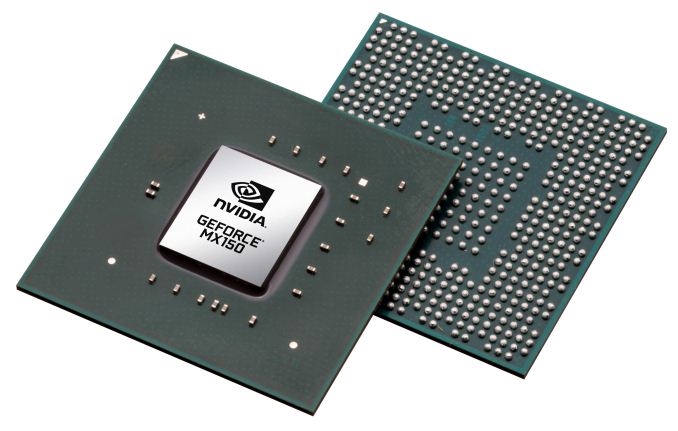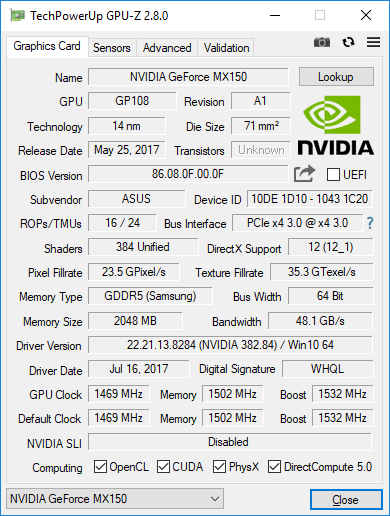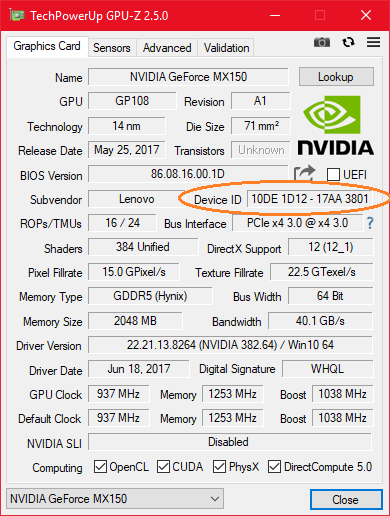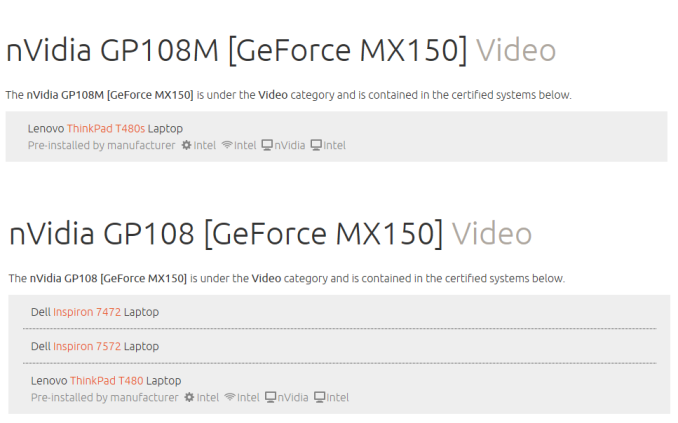NVIDIA Silently Rolls Out Slower, Lower TDP GeForce MX150 for Ultrabooks
by Nate Oh on March 23, 2018 2:00 PM EST
This week, Notebookcheck reported their findings of a second version of the GeForce MX150 – the newest version sporting lower base, boost, and memory clockspeeds versus the original SKU. Annoyingly however, these two versions are not being differentiated in advertising by NVIDIA or by OEMs.
Diving into matters, it looks like this second MX150 is designed to be a lower performing, lower TDP version for smaller ultrabooks. Notebookcheck cited their GPU-Z results as showing two different PCI IDs, comparing the standard ‘1D10’ and variant ‘1D12’ to find a default clockspeed difference of 36% for base, 17% for memory, and 32% for boost. In turn, they cited 3DMark tests in estimating a 20 to 25% performance drop for the “1D12’ MX150, where a number of 13 inch ultrabooks had this variant but was not disclosed.

 Notebookcheck's GPU-Z reports, with standard '1D10' N17S-G1-A1 GeForce MX150 in the Zenbook UX430UN (left), and slower '1D12' N17S-LG-A1 GeForce MX150 in the IdeaPad 320s-13kbr (right)
Notebookcheck's GPU-Z reports, with standard '1D10' N17S-G1-A1 GeForce MX150 in the Zenbook UX430UN (left), and slower '1D12' N17S-LG-A1 GeForce MX150 in the IdeaPad 320s-13kbr (right)
Further investigation on our part does reveal that there is a documented understanding that they are different parts, at least from an OEM perspective. By way of the official Ubuntu Certified hardware database, PCI ID ‘1D10’ is documented as the ‘GP108’ MX150 variant of the ThinkPad T480, while ‘1D12’ is recorded as the ‘GP108M’ variant of the ThinkPad T480s. In this case, although ‘GP108’ and ‘GP108M’ may not be NVIDIA’s own terminology, the Ubuntu Certified process involves OEMs directly working with Canonical to test their hardware. Canonical’s differentiation strongly implies that the OEMs are aware of MX150 variant.
Continuing with the ThinkPad as the prime case study, each product page has no indication of any difference in discrete graphics adapters, though the T480s is the thinner laptop variant. And while different cooling designs of laptops will change the exact clocks of the same GPU, the different PCI IDs and certifications suggest that this a vendor-side variant undisclosed to consumers.
In total, Notebookcheck also noted the presence of the slower MX150 in the ZenBook UX331UN, ZenBook UX331UA, Mi Notebook Air 13.3, Envy 13, and IdeaPad 320s. And a cursory look at The PCI ID Repository again corroborates the idea of the two corresponding ‘1D10’ and ‘1D12’ PCI IDs, with a GP108 Quadro variant in the P500. From the January/February dates of the Ubuntu certification and PCI ID Repository entries, we can say this development has been ongoing for several months at the least.
The engineering practicality isn’t in doubt here – constrained cooling designs of ultra-thin laptops necessitate lower discrete GPU clocks – but it appears that consumers were not notified of an explicit product difference. This is as juxtaposed with the OEM situation, where OEMs and/or NVIDIA did explicitly communicate to Canonical for the purposes of Ubuntu hardware certification. And while it is true that mobile and low-end (and especially mobile low-end) GPUs receive very little in terms of public documentation or vendor disclosure, this is why a lack of product transparency is a losing situation all around.
Though we only came across the Ubuntu Certified database entries after reaching out, NVIDIA has declined to comment on the matter. However, with what we have collated, there seems to be little reason to doubt the undisclosed slower MX150 variant.











40 Comments
View All Comments
kmmatney - Tuesday, March 27, 2018 - link
I'm also in the market for something similar. I don't think the 940MX is worth getting, The MX150 is about twice as fast as the 940MX, and is the slowest discrete cpu worth getting. There is also a low end Radeon 530 dGPU - about as fast as the 940MX, and I don't see the point in that one at all. Your right in the fact that the GTX 1050 isn't much more expensive, and is way much, although you'll need more cooling.I'm very impressed with the 8250u cpu - for heavy work loads is the same speed as the 8550u, and for light work loads is only a hair slower. An 8250u with a GTX 1050 would be a sweet spot for price/performance.
Valantar - Saturday, March 24, 2018 - link
Why Nvidia didn't simply name this the MX140 is beyond me. 25% performance variation within identically named products with no indication whatsoever that this is the case? Yeah, that's not okay.BigCapitalist - Saturday, March 24, 2018 - link
Only a total mental retardation would buy this GPU, much less the last one.AMD Vega is beating this thing with 2x the ram, 3x the performance for the same price.
Sadly the majority of consumers, probably 80% will buy the POS MX150 not knowing anything about specs, because people are in general stupid.
deepblue08 - Saturday, March 24, 2018 - link
They should call it MX150 SE like they did in the Geforce 4 days.SquarePeg - Saturday, March 24, 2018 - link
I think Nvidia got tired of people calling them the "Shitty Edition" GPU's.HStewart - Saturday, March 24, 2018 - link
What I would like is NVidia Version of 8709G EMIB on notebook - my biggest concern with 8709G as a future purchase of say Dell XPS 15 2in1 is support for profession 3d programs like Lightwave 3D 2018 - from what I can see so far Vega RX support is not too much in in professional graphic area.Khenglish - Sunday, March 25, 2018 - link
This whole thing of the clock reduction being Nvidia's fault is pure BS, it's Lenovo's.For mobile GPUs the way things have always worked is Nvidia (and AMD) recommends clocks to the OEM, and the OEM decides what clock they will actually ship. OEMs can even ship at higher than recommended clocks (ex. MSI 680m was 771 MHz while all others were 720 MHz), just like you see factory overclocked cards in the desktop space. Unlike in the desktop space though, OEMs can ship with lower than recommended, as you see here.
For around the past decade OEMs have been sticking very closely to the Nvidia recommended clocks. This is the first GPU in a while where shipped clocks are significantly below Nvidia recommended. In the early 2000s though it was very difficult to find any mobile GPU that actually shipped at the recommended clocks.
Memory implementation is also purely up to the OEM. An OEM can put DDR3 on a card instead of GDDR5 and call it the same card, despite it having half the memory throughput. This was done particularly often on Fermi and Kepler cards.
So in short, stop blaming Nvidia for something Lenovo did. If you want to complain about the Geforce Partner Program though... that does seem to be a very real thing to be upset with Nvidia over.
Spunjji - Monday, March 26, 2018 - link
You need to re-read the article. We are dealing with two distinct device IDs, so no, it is NOT a vendor-specific issue to do with the card being under-clocked in the system's BIOS.Differing amounts and quality of RAM were also, once again, an nVidia thing and not a vendor thing. They specifically allow for it in their specs so, yes, it is the vendor's choice which RAM they use but it is entirely nVidia's fault that the choice is invisible to the end user.
SaturnusDK - Monday, March 26, 2018 - link
Essentially you can just assume any product with an MX150 is basically just this "MX130ti" bottom of the barrel version unless it's explicitly stated that it the high TDP real MX150 used.MigRath - Tuesday, March 27, 2018 - link
For anyone who purchased a laptop with the underperforming MX150 GPU: The law firm of Migliaccio and Rathod LLP has recently opened an investigation into Nvidia's deceptive marketing of the GPU. As other comments have already noted, it is difficult to know which MX150 chip a notebook or ultrabook uses. Considering the fact that the slower MX150 variant takes a 20-25% performance hit over its identically-named counterpart, this is no small issue.More information is found here: http://www.classlawdc.com/2018/03/27/nvidia-mx-150...